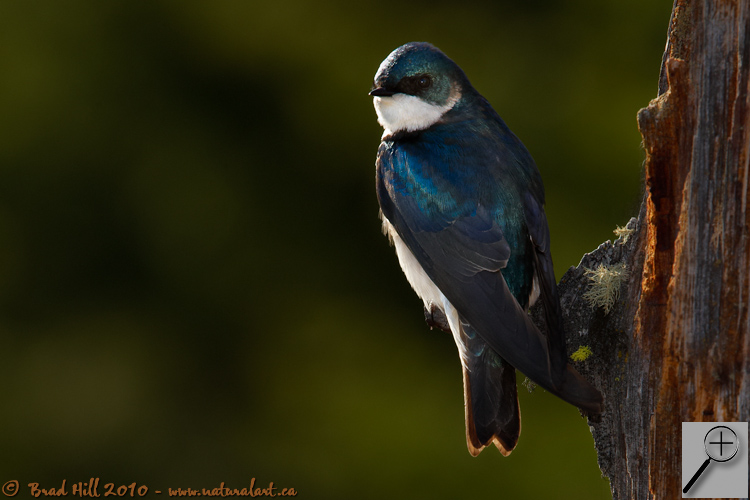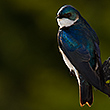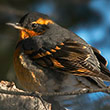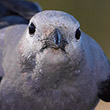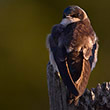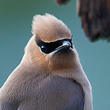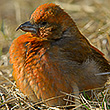Availability: Undetermined - Enquiries?
In the Field
Subtleties at Sunrise. Findlay Creek, BC, Canada. May 4, 2008.
Capturing, processing and presenting this image presented me with a whole host of challenges. The lighting on the subject- and the gorgeous perch - was absolutely "sweet". It was just minutes after the sun rose above the horizon and the sun was gently caressing both the Tree Swallow and the decaying snag it was perched on. But the subject was strongly backlit and very contrasty. So, I had to be extremely careful in exposing the image - I had to avoid blowing out the near blinding highlights while trying to use just enough flash fill to bring out the colours of the bird's back and shoulders.
The processing of the image wasn't overly complicated (details can be found under the "At the Computer" tab), but it was a tad time consuming (probably 15 minutes from start to finish, which is considerably more time than I normally spend on a single image). The biggest struggle was in determining how much light to use on the shaded portions of the swallow. I wanted to keep the subject quite dark (as I remembered the original scene), but didn't want the image to appear absolutely black on "dim" monitors (that I knew would be used by some viewers). In the end I compromised and ended up going a little lighter than I would have for my own calibrated monitor or printer...
Deciding how to crop and then present the image online was my final hurdle. I original captured the image in a vertical (portrait) format. To my eye, a vertical format more closely mirrors this scene's "natural" symmetry. But, given the practical size constraints of showing images on the web (and the particular constraints of presentation on this website), going vertical didn't really allow me to present the subtle beauty and detail of the bird AND enough of the dramatic perch to do it justice. So my vertical/portrait orientation turned into a horizontal/landscape one for this presentation! But if I ever offer up this image as a Limited Edition Print, you can count on it being in a vertical format!
A final word about the subject. I realize this is "just" a Tree Swallow - a common and widespread species. But I find it particularly challenging (and fun) to try to find and expose the beauty in any and all species. And, sometimes it takes even MORE work with commonplace species than with the more charismatic or "sexy" ones (like bears).
Behind the Camera
Subtleties at Sunrise. Findlay Creek, BC, Canada. May 4, 2008.
Digital Capture; Compressed RAW (NEF) 14-bit format; ISO 400.
Nikon D3 with Nikon 200-400 mm f/4G ED-IF AF-S VR lens @ 400 mm supported on Gitzo 1348 carbon fibre tripod with Wimberley head. SB-800 flash (fill) mounted on Really Right Stuff flash bracket. VR turned to "On" and in "Normal" mode.
1/200s @ f11; -1.3 stop compensation from matrix-metered exposure setting; balanced i-TTL flash exposure with -0.3 stop compensation on SB-800.
At the Computer
Subtleties at Sunrise. Findlay Creek, BC, Canada. May 4, 2008.
RAW Conversion to 16 bit TIFF, including first-pass/capture sharpening, exposure compensation, and slight shadow/highlight adjustment using Phase One's Capture One 4. Multiple RAW conversions (3 at different exposure settings: -1.0 stops; +0.5 stops; +1.0 stops) in this case to both retrieve highlight detail on the top of the bird's head and throat and retrieve shadow detail on the bird's back and near shoulder (scapulars).
Further digital correction on 16-bit TIFF file using Adobe's Photoshop CS3. Adjustments included compositing and masking of all exposure versions. Other Photoshop adjustments included selective curves adjustment, selective saturation enhancement and selective sharpening for web output.
Conservation
Subtleties at Sunrise. Findlay Creek, BC, Canada. May 4, 2008.
Species Status in Canada*: This species is not designated as at risk.
The Tree Swallow (Tacycineta bicolor) is a common insect-eating aerobatic specialist found across much of North America. Tree Swallows nest in abandoned cavities in trees or in nest boxes provided for them by humans. The breeding range of the Tree Swallow is expanding southward and overall their populations appear to be increasing.
This Tree Swallow was photographed in the Columbia Valley of the East Kootenays of British Columbia, Canada. While this species is not currently considered at risk in this region, virtually all of Canada's aerial insectivores (to which the Tree Swallow is a member) have been exhibiting steep population declines in recent years. While the cause isn't fully understood, many believe that changes to the seasonality of their insect prey (including changes to when they are available in large numbers as prey) is thought to be the proximate cause of the decline. Many believe that this change in the seasonal abundance of their prey is being driven by climate change.
*as determined by COSEWIC: The Committee on the Status of Endangered Wildlife in Canada













